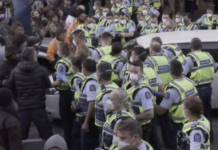
(Part 2 of series – See Part 1 here)
There is a rich history of working people in Aotearoa uniting and overcoming the divisions imposed on us.
In particular, during periods of working class upsurge, we see working people shake off the shackles of prejudice and ignorance and join hands in struggle.
In my own life, I have been witness to a number of instructive examples. I began my working life in 1970 as a meat worker in the Auckland works. I have worked in warehouses, car assembly, in a glue factory, a soap factory, and as an English language teacher. I was an active unionist and participated in numerous strikes. These included actions to attempt to improve conditions at work or actions that had a broader target such as opposition to wage controls by the government or to protest the arrest of a fellow unionist on the picket line.
During these decades, some unions also took action against the government’s international policies such as the sending of New Zealand troops to the Vietnam War, the support given to apartheid South Africa or the welcoming of US nuclear warships to New Zealand.
During the 1970s and 80s, there was an almost continuous rise in the class struggle – at least in terms of the number of people participating in strike action. At first, the unions were largely unfit to the tasks being demanded of them. The leaderships were overwhelmingly old, white men who had been tamed by earlier defeats in the 1950s and had lost faith in working people and their capacity to struggle.
Strengthening the ability of the unions to fight involved a process of both democratisation of the unions and involving broader and broader layers of workers in action. One elementary form of the democratisation process was to deepen the involvement of women, Maori, Pacifica and other migrant workers. Later there was a recognition of the oppression applying to LGBT workers. That also meant acknowledging the weaknesses that existed in structural terms but also a basic acknowledgement of the needs of these workers as women, Maori, and Pacifica workers. The working class was no longer – if it ever had been – a bunch of white men.
Typical of these transformations was that of the Hotel Workers Union in Auckland. A young militant Maori worker by the name of Matt McCarten led a rank and file revolt in the early 1980s that ousted the old leaders, organised militant strikes and other struggles including Hotel occupations that massively increased the membership at the same time.
As a consequence, the unions were drawn into the struggles against sex and race discrimination, in support of Maori struggles for land and language rights, protests against police violence, as well as rejecting the racist scapegoating of Pacifica workers during periods like the those when “dawn raids” were commonplace.
Unions also had to adapt to the push by women in traditionally “male” industries like the meat works to open up the more skilled and better-paid jobs to women. I was a worker at the Westfield meat works when women workers took cases to the Human Rights Commission and won the right to work as butchers. Workers at Westfield generally were not opposed to these efforts – more a case of being a bit bewildered and bemused. But as soon as women stepped-up and proved the could do the work they were usually strongly defended by their fellow workmates.
Unions supported the Maori Land March in 1975 and imposed a “Green Ban” on the sale and development of Maori land at Bastion Point in 1976. A “Working Women’s Charter” – a powerful and radical programme for women’s rights – was debated and voted on at mass meetings of workers across the country in the late 1970s before being adopted by the Federation of Labour in 1980. It included demands for equal pay, 24-hour child care, abortion rights, an end to discrimination on the basis of gender or sexual orientation.
I remember one union meeting in particular. There were 1500 members of the Northern Drivers Union filling the Auckland Town Hall. They were overwhelmingly male. I was there to support a female comrade presenting the motion to support the charter who inauspiciously was subjected to catcalls and whistles as she walked towards the stage. My friend made a strong argument that endorsing the charter would help not just women workers but all working people and their families. After a serious debate, the charter was endorsed overwhelmingly by the workers present. This was true in meeting after meeting across the country during the years 1977-80. And it was true for so-called “male” unions as much as for those with strongly mixed membership.
Many of the Maori working class leaders emerging from struggles in those years were naturally part of more narrowly defined “union” struggles as well as leading organisations dedicated to promoting Maori rights. For example, the leaders of the Gear Meat Workers Union in Wellington were also leaders of Maori land rights groups in Wellington. It was natural then that the Gear Meat works went on strike to protest the eviction of protestors from the occupation at Bastion Point in May 1978.
In fact, the merging of union and social protests during this decade saw the ruling class retreat and adopt a new strategy to try to capture and co-opt Maori rather than end up in an endless cycle of confrontations.
Up to this point, the National Party was an openly racist party. Election adds in 1975 for example had racist caricatures of Pacific Islanders beating up people.
White South Africans were referred to as being “our kith and kin” by then Prime Minister Robert Muldoon.
Through the mid-1970s Maori and Pacifica were rounded up on the streets and asked for their passports to try and identify Pacific island “overstayers”.
When police were criticised for these random checks a National government minister justified the police action by arguing that if a Friesian cow with black and white markings was in a herd of light brown Jersey cows then it was natural for the police to check the Friesian.
1982 saw Samoans stripped of citizenship rights granted by the Courts to those born in Samoa during the period of New Zealand’s colonial rule. This was done in a late night session of parliament with both the Labour and National parties working together.
The Labour Party was the traditional party for Maori workers to vote for. Maori remembered the fact that it was the 1935-49 Labour Government that had given them the same access to welfare as other citizens. Labour was also credited with creating full employment and providing state housing.
There was almost a total absence of a Maori professional or middle class except for a small number of relatively affluent farmers. When I went to Auckland University in the early-1970s fewer than 100 Maori attended.
The election of the Labour Government in 1984 allowed for a change in course from direct racism towards opening up spaces for some Maori to advance. This was especially true for professionals in health, education and other public services. For most Maori, this government was actually a disaster as tens of thousands of jobs were being slashed in the Railways, the Ministry of Works and other state enterprises where many Maori worked as they were corporatised in preparation for eventual privatisation.
The 1984-90 Labour government had an extreme free-market economic policy dubbed “neoliberal” which was normally associated with reactionary right-wing and racist governments like those in the UK under Margaret Thatcher and the US under Ronald Reagan from the same period.
In New Zealand however, the government was able to use concessions that would appeal to the liberal left on issues around sex and race discrimination, together with some foreign policy actions like expelling the South African Ambassador and banning nuclear ships, to blunt the opposition to the economic reforms. At least in terms of many middle-class leaders (including trade union ones) who could be bought off with perks and appointments that was partially successful.
The Waitangi Tribunal was also allowed to investigate claims from before 1975 – the year it was established. This opened the way to a series of compensation recommendations that involved the transfer of some money and land to tribal entities. Both Labour and National have deliberately done this in a manner to promote a professional middle class of corporate-minded tribal leaders who can be used to negotiate and mediate problems away without the mass confrontations of the past.
The National government from 1990 to 1999 oversaw the deepest and longest recession in New Zealand history since the 1930s. Overall official unemployment figures topped 10 percent. For Maori and Pacifica families, however, it was the equivalent of the Great Depression with official unemployment rates hitting 25%.
Using the weapon of high unemployment, the bosses were able to push their agenda forward even more strongly. Real wages were driven down. Protective measures like overtime rates after eight hours or penal rates on weekends were eliminated. Health and Safety laws were degraded. Deregulation was the order of the day. The trade union movement collapsed across the private sector. The neoliberal counter-revolution begun by the 1984-90 Labour government was continued and completed.
A large part of the responsibility for the collapse in union strength during that period was that much of the central union leadership simply refused to fight.
The union bureaucracy’s retreat began with a dirty deal done with the previous Labour government to accept a ban on strikes during the contract period in return for a state-led forced merger of the smaller unions into bigger ones. This was accompanied by the merger of the more militant and democratic Federation of Labour made up mostly of private-sector unions with the more bureaucratic state sector union body to create the Council of Trade Unions in 1987. All local autonomy and power was eliminated in the process. The CTU leaders, of course, got promised lots of gravy-train “consultation” on government policy and appointments to various boards.
The only fight launched by the CTU leadership following its formation was a fight to the death against proposals for a general strike when the National Party government elected in 1990 introduced the Employment Contracts Act. A number of central leaders of the CTU had been members of the Socialist Unity Party trained in a bureaucratic variety of pro-Moscow Stalinism so the collapse of the Stalinist states in Eastern Europe and Russia at that time simply added justifications to their rightward leap to openly praising the so-called virtues of free market capitalism.
As a consequence of the huge working class defeats during these years action by working people collapsed to near zero and has largely remained there ever since. As a consequence large numbers of working people have simply had very few opportunities to fight together. This undermines the confidence and consciousness of the working class.
What came to be dubbed “Identity Politics” – that is a political approach that prioritised one’s identity over one’s class – became dominant in middle-class liberal-left circles. Class was dismissed as no longer relevant or important. This included a number of Labour Party MP’s and functionaries.
This was an inevitable consequence of the retreat of the working class.
In an odd reversal of cause and effect, some left-wing commentators like Chris Trotter seem to blame the working class retreat on the rise of identity politics rather than the other way around.
A disappointing aspect of the retreat was the fact that union officials seemed to be focused on protecting their own positions and high salaries through bureaucratic mergers over organising the unorganised. Many unions seemed to turn the groups inside the unions which had been formed to empower workers from oppressed groups into inwardly focussed talking shops rather than organising centres.
Many of the new middle-class Maori leaders incorporated into the state, corporate and iwi bodies also seemed to simply ape the excessive salaries, bad taste and extravagance of their Pakeha “colleagues’.
It was a principal of the socialist movement that workers representatives, whether they are in parliament, on local bodies or employed by unions should only receive the pay of an average skilled worker. Maybe it is time to revive that rule and look at applying it to other voluntary and co-operative organisations as well as elected tribal bodies.
While many union officials and middle-class Maori were focussed on protecting themselves from the consequences of the social crisis during the 1990s, the big majority of working people – including and especially Maori – emerged in a far worse state than they entered.
The 1990-1999 National government, however, continued the process of settling Waitangi Tribunal claims. The “liberal” face of New Zealand capitalism continued as before. The Tory prime Minister Jenny Shipley attended the 1999 Gay Pride parade.
National also largely gave up on overt racism as an electoral tool except for the 2005 campaign run by the then leader Don Brash. Brash’s campaign did increase the National Party’s share of the vote from the historic lows of 2002 under the then leader Bill English but not enough to secure a majority.
It probably shocked many that racist sentiments were as deep and widespread as they were. The problem for National is that under a proportional system of election, and given the demographic changes being produced by migration to new Zealand with 25 percent of the country’s population not born here, it is difficult maintaining a majority with such overtly racist policies. Brash was forced to resign after a book exposing his methods was published. This included the fact that the use of racist dog-whistles like “Iwi or Kiwi” was entirely cynical and manipulative.
Following John Key’s election as leader in November 2006, he moved to the centre again on these issues and was able to form coalition governments with the Maori Party from 2008 until today.
The Maori Party now explicitly represents a pro-capitalist upper-class layer in Maori society that is happy to compete for contracts from the state. For the government, this has the added advantage of furthering the privatisation agenda into the realm of education, welfare and housing by claiming the state has failed Maori in these areas – which, of course, is true. But the solutions being implemented will inevitably end up in a dead end for the big majority of Maori again.
The Mana Movement’s establishment in 2011 represented a progressive split from this orientation. The founding leader Hone Harawira, who had in the past been closely identified with more narrow nationalist arguments around asserting Maori rights became an articulate advocate of a class-based approach to fighting poverty and inequality. He openly acknowledged that the majority of poor people in this country were white – without, of course, ignoring the fact that the unequal impact of those social diseases on Maori in Aotearoa today means that a significantly larger proportion of Maori are poor than their Pakeha compatriots.
I believe it was correct for socialists and working class militants to embrace this political development. It provided a basis for a fighting alliance of Maori who wanted to struggle “by any means necessary” for the liberation of their people and working class activists who are white who wanted a class struggle oriented labour movement. That initial effort appears to have also run into a roadblock with no clear way forward. Again it is mainly objective obstacles that exist as a consequence of the very low level of broader working class struggle. We can only hope that the lessons that are there to be learnt can be absorbed and acted on in the future as new struggles emerge among Maori and the broader working class.





This is a worthwhile and thoughtful perspective piece of NZ history. Thanks Mike.
“It was a principal of the socialist movement that workers representatives, whether they are in parliament, on local bodies or employed by unions should only receive the pay of an average skilled worker. Maybe it is time to revive that rule and look at applying it to other voluntary and co-operative organisations as well as elected tribal bodies.”
I see this as a key point, because the incentives for those on the Left to abandon comrades are tantalizing, and many. For any movement to be successful, it must keep corruption out of its own ranks. One of the problems of Labour as it stands today, is that it has become far too detached from its worker roots, its roots in class struggle. It’s become a political party first and foremost, and a workers party mostly only in branding, for the reasons you point out – and that suits many party insiders just fine.
I see worker co-operatives, as enunciated by Richard Wolff, as an avenue to take the class struggle forward. The worker co-operatisation of corporations could only yield more equal outcomes between classes at work and in policy. As far as I am concerned, Labour ought to be championing the co-operative economy.
i agree about worker co-operatives. I think that people need to have the experience of mutual struggle, support and success to really understand the power of the working people to re-shape our future.
i agree about worker co-operatives. I think that people need to have the experience of mutual struggle, support and success to really understand the power of the working people to re-shape our future.
“Up to this point, the National Party was an openly racist party. Election adds in 1975 for example had racist caricatures of Pacific Islanders beating up people. ”
http://www.teara.govt.nz/en/video/2158/national-party-advertisement – that looks like something Donald Trump was spouting during his election campaign last year.
Excellent assessment. Thanks, Mike!
Comments are closed.